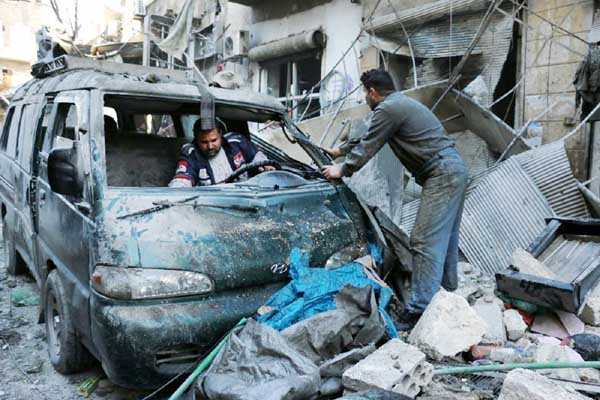
Reuters, Beirut :The Syrian Observatory for Human Rights group said scores of Syrian government forces have been killed in three days of fighting with Islamic State in the east of the country, where the jihadist group has attacked government-held areas. Syrian officials could not be reached for comment.The Britain-based Observatory said 120 members of the Syrian government forces and 70 Islamic State fighters had been killed in clashes since Saturday.The official news agency SANA reported on Monday that government forces had recaptured some residential areas taken by Islamic State in Begayliya, near the city of Deir al Zor, and killed a number of fighters.Salma, Syria: As Syrian forces battled to recapture the rebel stronghold of Salma last week, they relied not only on Russian air support but also a secret weapon: motorbikes.Adapting a tactic used by both their rebel opponents and the pro-regime fighters of Lebanon’s Hezbollah movement, government forces used dozens of the vehicles to navigate the town’s tiny alleys.Soldiers said they were key to the recapture of Salma, a town that was a rare rebel stronghold in the regime bastion of coastal Latakia province.Syrian army soldier Hany, 25, said he spent most of the past nine months on a motorbike, fighting street battles for the town that fell from government control in 2012.”The way we fight has changed since the beginning of the war, and we have developed our offensive methods,” he said, dismounting from his muddy vehicle after a spin through the recaptured town.”Nowadays, we use motorbikes for their speed and mobility,” he said.While rebel snipers managed to hit a car delivering meals to regime forces several times, Hany said he could outmanoeuvre such fire.”My bike is harder to track and is too light to set off landmines,” he said.While small, Salma’s many narrow alleys, and the forests and hills that surround it, made the fight for its recapture long and hard. Some of the streets were entirely unnavigable with cars, armoured vehicles or tanks, troops said.”It was the use of more than 80 motorbikes in the last battle for the town that had the greatest impact in terms of winning in the final 72 hours,” one field commander told AFP.”The motorbikes allowed us to transfer the wounded, carry light ammunition and food and were used by fighters carrying machine guns and night vision binoculars,” he said.He too had ended up riding one to inspect his troops and front lines.”I check on my troops by motorbike because they are fast and light, and much more difficult to track than a car would be,” the commander said.Motorbikes have long been used by rebels in Syria and beyond, and the commander acknowledged the tactic is one regime forces picked up from their foes.”We don’t deny that we learned the tactic of using motorbikes from the militants,” he said.”We’ve come up with an advanced course on street fighting and guerrilla warfare, and fighting on motorbikes may become a tactic that regular armies come to rely on,” he added.Another soldier, 38-year-old Reda Haj, said his first encounter with motorbikes on Syria’s battlefields was in Qalamun in Damascus province, where the pro-regime Hezbollah movement used them.The Shiite militant group has been a key force multiplier for the Syrian regime, fighting alongside its troops on several fronts.

